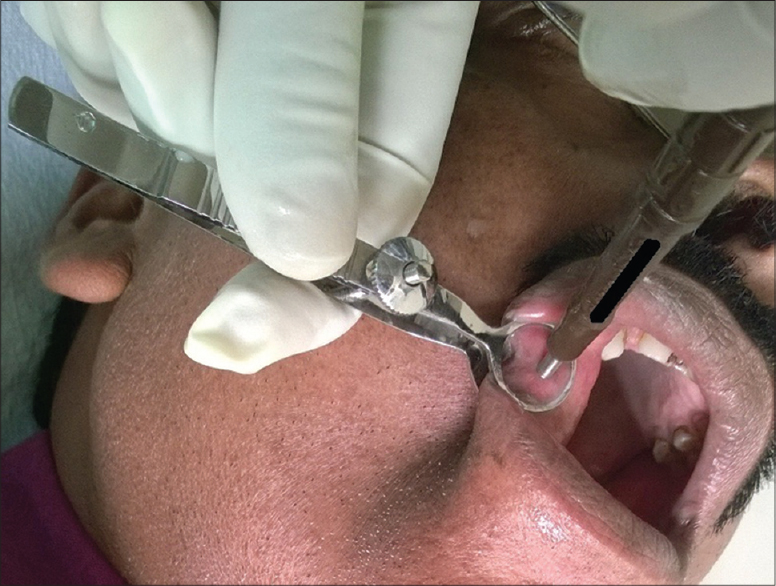Translate this page into:
Chalazion clamp in dermatology revisited
2 Department of Dermatology, Venereology and Leprosy, Pondicherry Institute of Medical Sciences, Pondicherry, India
Correspondence Address:
Abhijeet Kumar Jha
Department of Dermatology, STD and Leprosy, All India Institute of Medical Sciences, Patna - 801 505, Bihar
India
| How to cite this article: Jha AK, Ganguly S. Chalazion clamp in dermatology revisited. Indian J Dermatol Venereol Leprol 2015;81:280-281 |
INTRODUCTION
The use of chalazion clamp has been lost in the dermatology literature. Chalazion clamp is helpful for surgical procedures on oral mucosa as these tissues are moist, vascular, and pliant. We describe the use of the chalazion clamp in performing oral, tongue and inner lip biopsy in various dermatological disorders as well as its use as a tool for therapeutic purposes. Mucosal biopsy is essential for diagnosis of several skin disorders. Any biopsy or excision in the oral mucosa is associated with heavy bleeding which obscures the field of vision of that particular area. The use of chalazion clamp facilitates the procedure and gives us a relatively bloodless area and a firm surface to work on, thus increasing the chance of a good mucosal biopsy. This instrument can also help us in other therapeutic modalities.
Chalazion clamp has a forceps-like handle with one distal tip with a flat solid oval plate and another distal tip with a ring-like aperture. The shaft has a thumbscrew, which can be tightened to bring the distal tips together. This is used in ophthalmologic surgery for removal of a chalazion, hence known as chalazion clamp. Chalazion clamps can be disposable or reusable and are commonly available in three sizes, small (ring size: 11 × 17 mm), medium (ring size: 12 × 23 mm) and large (ring size: 17 × 28 mm). [1] For dermatological purposes, small disposable or reusable chalazion clamp can be used as it encloses sufficient area to take a incisional or punch biopsy. In 1970, Garcia and Davis demonstrated the use of chalazion clamp to assist small dermatological procedures in the dermatologist′s daily practice. [2]
Indications
- Oral mucosal lesions
- Oral mucosal biopsy
- Deroofing of mucocele
- Minor salivary gland biopsy [3]
- Ear lobe repair
- Scrotal surgery
- Nasal lesions on ala nasi.
Procedure
After informed consent, local anesthesia (field block) using lignocaine and adrenaline is given by injecting around the lesion using a 30 gauge needle. Chalazion clamp [Figure - 1] is then chosen depending on the size of the lesion. The ring portion of the forceps should be facing the mucosal surface [Figure - 2], whereas the other flat side of the forceps should be on the cutaneous surface. Then, the clamp is tightened. The biopsy is taken using punches of different sizes based on the requirement. Hemostasis should be achieved by applying small gauze pads to the area followed by removal of the chalazion clamp by loosening the screw. Absorbable suture using 3-0 plain or chromic catgut should be used. [4] Stay suture to be taken at the lesion prior to beginning the biopsy procedure has also been recommended. [5]
 |
| Figure 1: Chalazion clamp |
 |
| Figure 2: The ring portion of the Chalazion clamp facing the mucosal surface |
Advantages
- It minimizes bleeding during surgery.
- It provides a firm immobile surface against which the lesions can be incised.
- It also helps to maintain a firm grip on the moist slippery oral mucosa.
- The clamp handle allows easy manipulation of the surgical site during surgery. When operating upon the ear lobule it is difficult to hold and operate at the same time because of its small size. Chalazion clamp can be of help as it fixes the tissue and makes it easier to hold.
- The screw clamp allows variability of the pressure exerted, allowing hemostasis without crushing the tissues. Since there is a limiting screw adjustment, pressure necrosis due to the chalazion clamp is unlikely.
- When the pressure is released by unscrewing the dial on the clamp, as the clamp loosens, the bleeding points can be precisely identified and carefully cauterized.
Modifications
The modified Harvey chalazion clamp has a concave open portion rather than convex open portion of the traditional chalazion clamp. This modified version mimics the natural concavity of the eyelids and the oral mucosa. [6]
| 1. |
Amir I, Marmur ES, Kriegel DA. Bloodless nasal alar Surgery: Another Innovative Use of the Chalazion Clamp. Dermatol Surg 2009;35:843-4.
[Google Scholar]
|
| 2. |
Garcia RL, Davis CM. Chalazion clamp for dermatological surgery. Arch Dermatol 1970;102:693.
[Google Scholar]
|
| 3. |
Neto Pimentel DR, Aparecida Milanez M, de Abreu MA, Hirata CH, de Avelar-Alchorne MM, Weckx LL. Use of chalazion clamp for minor salivary gland biopsy in the diagnosis of Sjögren′s syndrome. Surg Cosmet Dermatol 2009;1:145-6.
[Google Scholar]
|
| 4. |
Savant SS. Basics of Cutaneous Surgery. In: Valia RG, Valia AR, Editors. IADVL text book of Dermatology. 3 rd ed. Mumbai: Bhalani Publishing House; 2008. p. 1687-709.
[Google Scholar]
|
| 5. |
Savant SS. Skin biopsy techniques. In: Savant SS, Editor. Textbook of Dermatosurgery and Cosmetology. 2 nd ed. Mumbai: ASCAD; 2005. p. 72-80.
[Google Scholar]
|
| 6. |
Harvey DT. The modified Harvey chalazion clamp [Internet]. 2013. Available from: http://mydermsurgery.com/the-harvey- chalazion-clamp/ [Last cited on 2014 Dec 14].
[Google Scholar]
|
Fulltext Views
9,982
PDF downloads
3,843





